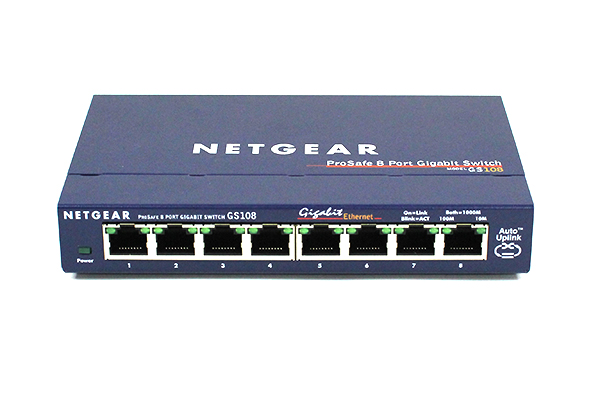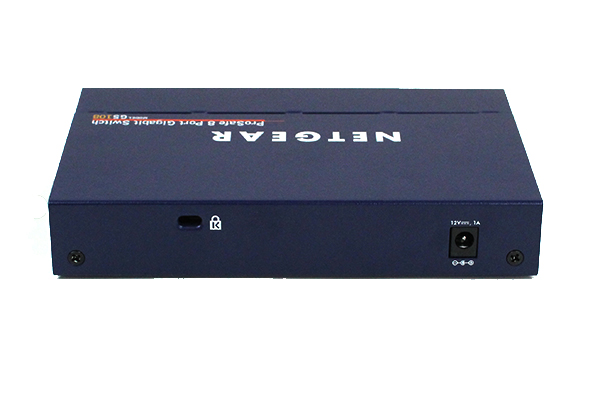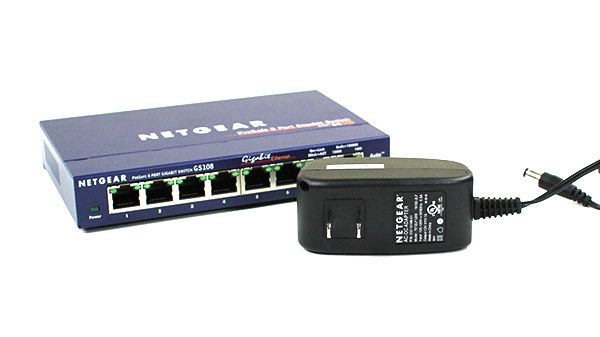The Netgear an 8-port gigabit Ethernet switch that comes from one of the more mature brands in SMB networking. We purchased the review sample for $50 on Amazon.com which is about $6.25 per port. Much like the other NETGEAR units we have seen, such as the NETGEAR ProSafe GS105 we reviewed earlier this year, the GS108 utilizes a metal chassis making it feel fairly sturdy. Since the switch is an unmanaged gigabit switch, it is a relatively simple device. NETGEAR is seen as a leader in this segment. Let’s see how the GS108 stacks up.
NETGEAR is seen as a leader in this segment. Let’s see how the GS108 stacks up.
Look and Feel
Overall the NETGEAR GS108 feels sturdy. The metal chassis is rugged enough for most home and office uses. Significantly more than the TRENDnet TEG-S80g we reviewed recently. Like the NETGEAR GS105, the eight RJ-45 ports are found on the rear of the unit and the status indicators are found on the RJ-45 ports. We generally prefer this method as it is easier to troubleshoot cables if the LEDs are on the same side.

The chassis design is familiar for those in IT who have seen generations of these switches. Our test version is a V3 product. Power consumption is reasonable as we will see, so there there is no need for an additional active fan. As a result the switch stayed very quiet during testing. The lack of fan also means the switch will have lower power consumption.
Performance Impressions
The NETGEAR GS108 advertises 16gbps switching which is equivalent to what we would expect from eight full duplex gigabit ports (8 ports * 2 gbps per port.) For some users having switching capacity equal to the full speed of all ports will be important but most of these will not be deployed in environments where they are run at 100% 8-port capacity. During switch testing we spend a few days generating “normal” traffic, one port streaming HD Netflix on a PC, four ports backing up files to a NAS that occupied two ports and two servers doing file transfers back and forth. The Gs108 gigabit switch fared well. As an aside, we have been running a NETGEAR GS108NA embedded in a lab wall for over 20 months now and have never needed to reboot it.

NETGEAR’s metal chassis includes a Kensington lock port. Although this switch may be less expensive than many locks, a lock could be useful. The removal of a switch from a small office can cause business to halt for a period of time until a replacement is found. Certainly this is not a must-have feature but is important if IT policy dictates that a lock must be used.
NETGEAR GS108 Power Consumption
Overall power consumption on the NETGEAR GS108NA was slightly higher than expected. Boot power consumption peaked at 3.4w on the Extech 380803 True RMS power analyzer. Here are some quick stats:
- Boot power consumption: 3.4w
- Idle power consumption (no RJ-45 active): 1.5w
- Idle power consumption (2x RJ-45 active): 2.6w
- Idle with 8x RJ-45 gigabit links: 6.2w
- Active power consumption with 2x RJ-45 gigabit links: 3.1w
- Active power consumption with 8x RJ-45 gigabit links: 6.8w
The figures were captured using relatively short 2 meter CAT6 cables which generally lowers power consumption on modern switches. Specs would lead one to believe that this unit would see sub 5w operating power consumption. On the other hand, we measure at the wall versus the device itself to include loss from power supplies.

NETGEAR includes a power adapter that aligns in parallel with the North American 2-prong power outlet. On standard power strips, this gives greater flexibility regarding where it can be placed. This is important because at this class/ cost of device, it generally makes sense to just purchase a different switch than a different surge protector/ APC to get the power port layout one needs. In a future revision, we would like to see the adapter streamlined so that it takes up no more footprint on a power strip than a standard 3-prong outlet.
NETGEAR GS108 Features
[tabgroup][tab title=”NETGEAR GS108 Features”]
- Network Ports
- 8 auto-sensing UTP ports
Forwarding Mode
- Store-and-forward
- 192 KB on-chip packet buffering
Performance
- Bandwidth: 16 Gbps (non-blocking)
- Forwarding rate:
– 10 Mbps port: 14,800 packets/sec
– 100 Mbps port: 148,000 packets/sec
– 1000 Mbps port: 1,480,000 packets/sec - Latency (using 1500-byte packets):
– 10 Mbps: 30μs (max)
– 100 Mbps: 6μs (max)
– 1000 Mbps: 4μs (max) - MAC address database: 4,000
- Mean time between failures (MTBF):
>1 million hours (~114 years)
Status LEDs
- System power
- Link, speed, and activity indicators per port built into each RJ-45 port
AC Power
- Power adapter: 12W, 12V DC, 1A
- Maximum power consumption:
– 4.92W (if cable length > 10 m)
– 4.08W (if cable length < 10 m)
Physical Specifications
- Dimensions (w x d x h):
158 x 105 x 27 mm (6.2 x 4.1 x 1.1 in) - Weight: 0.522 kg (1.15 lb)
Environmental Specifications
- Operating temperature: 0º to 50º C (32º to 122º F)
- Operating humidity: 10% to 90% non-condensing
- Storage temperature: -20º to 70° C (-4º to 158º F)
- Storage humidity: 10% to 95% relative humidity
Standards Compliance
- IEEE 802.3i 10BASE-T Ethernet
- IEEE 802.3u 100BASE-TX Fast Ethernet
- IEEE 802.3ab 1000BASE-T Gigabit Ethernet
- Honors IEEE 802.1p and DSCP priority tags
- Jumbo frame: up to 9,720 bytes
System Requirements
- 10 Mbps: UTP Cat 3 (or better)
- 100 Mbps: UTP Cat 5 (or better)
- 1000 Mbps: UTP Cat 5e (or better)
Warranty
- Switch: NETGEAR Lifetime Warranty
- Power adapter: NETGEAR 2-year warranty
[/tab][/tabgroup]
Conclusion
Overall, the NETGEAR GS108 is a solid unmanaged gigabit switch. The unmanaged nature means that it will not provide many of the advanced features some administrators may want. It does provide basic switching features including support for jumbo frames. With all of that said, perhaps one of the biggest value points with this switch is the longevity/ stability that these products have had for NETGEAR over the years. While the fact of the matter is that electronic products do have a defect rate, and so there are always going to be some DOA products that get to customers, this line of NETGEAR products is very popular due to the simplicity and reliability.





I’ve had one die on me after 4 years of use. It started blinking random LEDs and could not hold a connection.
We used the 16 port version for a few years at work for our PC imaging station. Did the job, and also just died. Same thing happen with a few 8 ports we had in various conference rooms.
Can’t say I recommend it…
I agree with the above 2 commenters, Ive avoided the netgear ones for some time, the two 16 port version of this I purchased and used, often got their knickers in a twist and had to be switched on and off / reset to make come back alive after some of the ports became unrelaibel of if all ports used became unreliable, and these 16 port ones died one after another, or there power supplies did, whichever way these reviews dont and cant take account of longevity or reliability, and in my experience the netgear for all theyre brand and metal casing, are not good, wierdly cheap smaller tp-link ones have lasted longer ?
Don’t you have lifetime warranty on this device?
Bye,
Emanuele
The metal case has a lifetime expectancy of 114 years… the power brick and the electronics inside the switch do not. They both will be obsolete by then, but in 114 years, you can still use the metal case to… I don’t know… store your watches and jewelry on.